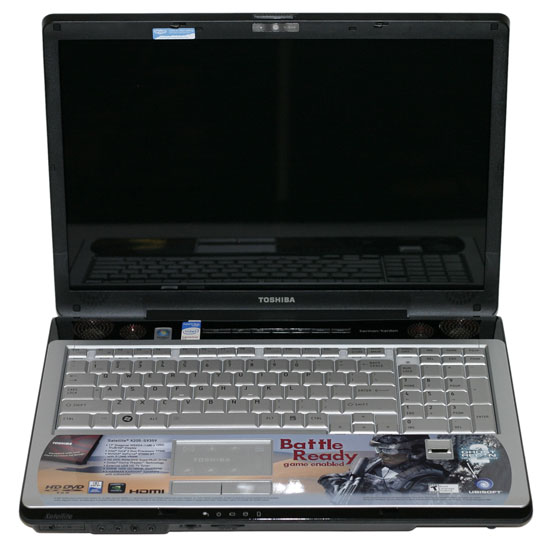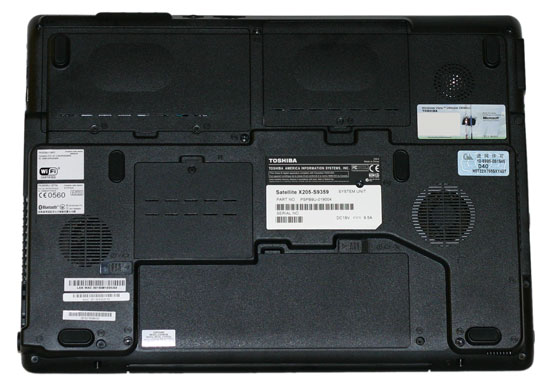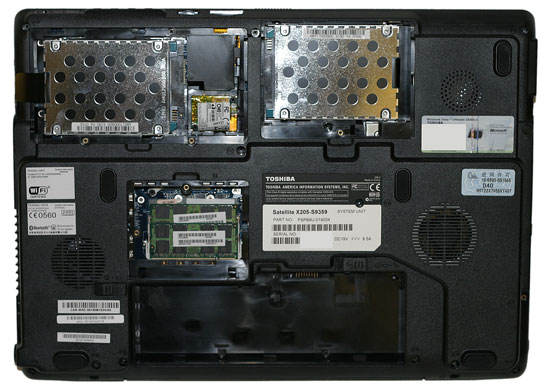Toshiba Satellite X205-S9359: DX10 to go, please!
by Jarred Walton on August 31, 2007 8:00 AM EST- Posted in
- Laptops
Design and Appearance (Cont'd)
Lifting the lid and taking a look inside, users might actually get pretty excited to start playing some games on this notebook. Toshiba places a large sticker on the palm rest that lists most of the laptop features, along with providing an advertisement for Ghost Recon Advanced Warfighter 2. Given the large advertisement, we were a bit surprised that the game isn't even included (though plenty of other software comes preinstalled). Luckily, the sticker is designed to peel off without leaving any residue, something we certainly would have done if we were planning on keeping the laptop. The palm rest and keyboard are made of a silver plastic compound, while the remainder of the casing is a black plastic.
Our last three laptop reviews have commented on the quality of the keyboards and how much we like having a full-size keyboard with a dedicated 10 Key pad. The PC Club ENP660 had to work to cram all the keys into a 15.4" chassis, while the 17" chassis has a bit more room and generally works out better. Alienware had a good key layout with a few areas that we felt needed improvement. We hadn't actually used the Toshiba X205 at the time we were working on the Alienware review, but it turns out that Toshiba got the keyboard pretty much perfect. You get a full 104-key keyboard, and the Fn key is only needed to access certain laptop specific functions (i.e. increase/decrease LCD brightness, disable/enable touchpad, sleep, lock, etc.) As far as we're concerned, there's really nothing that needs to be done to improve the keyboard layout.
The touchpad on the other hand is a bit odd. For the most part it functions as you would expect, but if you tap the top right corner it glows blue and provides access to additional functions. There are six application quick launch buttons in the main area, and a volume control on the right. Some people might find this to be more useful, but we accidentally engaged this function quite a few times during testing, and it was always disconcerting. Suddenly the mouse cursor would stop moving, and for a moment we'd move our finger around trying to figure out what was going on. Then we'd look down and notice the glowing touchpad. The six quick launch applications are user configurable, but we're still not really convinced that this feature is necessary.
The bottom of the notebook has three small compartments secured by four screws that provide access to the memory slots and hard drives, as well as the mini-PCI slot. Anyone interested in getting at the graphics chip or processor will have to remove quite a few more screws. It's not readily apparent from this angle, but much of the bottom of the laptop is set about a quarter inch deeper than the middle section. This middle section is used for airflow to help cool the CPU, GPU, memory, and chipsets.
Pulling off the three covers, there's still not much to see other than a couple of hard drive sleds and the SO-DIMMs. Again, for reference, the SO-DIMMs are about a half inch below the surface of the cover. There's really quite a bit of room for air to move through the center section. Not surprisingly, we found that the laptop generally ran quite cool relative to other 17" laptops.
Toshiba includes a 9-cell 65 WHr battery, which falls somewhere in between the 50 WHr batteries used on many smaller notebooks and the 95WHr battery used on the Alienware m9750. Not pictured is the external power adapter, which actually appears to be identical to the model used on the Alienware m9750, other than the fact that the laptop connector is slightly different. When we first saw the adapter, we were quite shocked. We can understand the need for a 180W power brick for something like the m9750, but considering the lack of SLI and the use of a lower performance graphics chip, we really doubt that we'll get anywhere near drawing 180W of power. Of course, better to have more than enough power than to fall short at times.
As a whole, the design and construction of the Satellite X205 makes some interesting compromises. The feet on the bottom of the notebook definitely help keep the internals cool when the notebook is sitting on a hard surface, but anyone looking for a thinner design will be disappointed. Then again, most people looking for thinner, lighter notebooks probably aren't considering a 17" chassis regardless. Potential buyers will want to make sure they get an appropriate carrying case for the laptop, however, as we did have our own 17" notebook bag in which we were unable to place the X205 due to its size. If you can get past the slightly larger design, though, we found a lot to like about this laptop. The protruding feet are not really comfortable to have sitting on your two thighs, but the flip side is that if you want to have the laptop straddle one thigh the center section is open and you won't be blocking off any air intakes. The attractive exterior and basically perfect keyboard layout more than make up for any other concerns in our opinion. However, we still need to see how this thing actually performs.
 |
Lifting the lid and taking a look inside, users might actually get pretty excited to start playing some games on this notebook. Toshiba places a large sticker on the palm rest that lists most of the laptop features, along with providing an advertisement for Ghost Recon Advanced Warfighter 2. Given the large advertisement, we were a bit surprised that the game isn't even included (though plenty of other software comes preinstalled). Luckily, the sticker is designed to peel off without leaving any residue, something we certainly would have done if we were planning on keeping the laptop. The palm rest and keyboard are made of a silver plastic compound, while the remainder of the casing is a black plastic.
 |
Our last three laptop reviews have commented on the quality of the keyboards and how much we like having a full-size keyboard with a dedicated 10 Key pad. The PC Club ENP660 had to work to cram all the keys into a 15.4" chassis, while the 17" chassis has a bit more room and generally works out better. Alienware had a good key layout with a few areas that we felt needed improvement. We hadn't actually used the Toshiba X205 at the time we were working on the Alienware review, but it turns out that Toshiba got the keyboard pretty much perfect. You get a full 104-key keyboard, and the Fn key is only needed to access certain laptop specific functions (i.e. increase/decrease LCD brightness, disable/enable touchpad, sleep, lock, etc.) As far as we're concerned, there's really nothing that needs to be done to improve the keyboard layout.
The touchpad on the other hand is a bit odd. For the most part it functions as you would expect, but if you tap the top right corner it glows blue and provides access to additional functions. There are six application quick launch buttons in the main area, and a volume control on the right. Some people might find this to be more useful, but we accidentally engaged this function quite a few times during testing, and it was always disconcerting. Suddenly the mouse cursor would stop moving, and for a moment we'd move our finger around trying to figure out what was going on. Then we'd look down and notice the glowing touchpad. The six quick launch applications are user configurable, but we're still not really convinced that this feature is necessary.
 |
The bottom of the notebook has three small compartments secured by four screws that provide access to the memory slots and hard drives, as well as the mini-PCI slot. Anyone interested in getting at the graphics chip or processor will have to remove quite a few more screws. It's not readily apparent from this angle, but much of the bottom of the laptop is set about a quarter inch deeper than the middle section. This middle section is used for airflow to help cool the CPU, GPU, memory, and chipsets.
 |
Pulling off the three covers, there's still not much to see other than a couple of hard drive sleds and the SO-DIMMs. Again, for reference, the SO-DIMMs are about a half inch below the surface of the cover. There's really quite a bit of room for air to move through the center section. Not surprisingly, we found that the laptop generally ran quite cool relative to other 17" laptops.
 |
Toshiba includes a 9-cell 65 WHr battery, which falls somewhere in between the 50 WHr batteries used on many smaller notebooks and the 95WHr battery used on the Alienware m9750. Not pictured is the external power adapter, which actually appears to be identical to the model used on the Alienware m9750, other than the fact that the laptop connector is slightly different. When we first saw the adapter, we were quite shocked. We can understand the need for a 180W power brick for something like the m9750, but considering the lack of SLI and the use of a lower performance graphics chip, we really doubt that we'll get anywhere near drawing 180W of power. Of course, better to have more than enough power than to fall short at times.
As a whole, the design and construction of the Satellite X205 makes some interesting compromises. The feet on the bottom of the notebook definitely help keep the internals cool when the notebook is sitting on a hard surface, but anyone looking for a thinner design will be disappointed. Then again, most people looking for thinner, lighter notebooks probably aren't considering a 17" chassis regardless. Potential buyers will want to make sure they get an appropriate carrying case for the laptop, however, as we did have our own 17" notebook bag in which we were unable to place the X205 due to its size. If you can get past the slightly larger design, though, we found a lot to like about this laptop. The protruding feet are not really comfortable to have sitting on your two thighs, but the flip side is that if you want to have the laptop straddle one thigh the center section is open and you won't be blocking off any air intakes. The attractive exterior and basically perfect keyboard layout more than make up for any other concerns in our opinion. However, we still need to see how this thing actually performs.










12 Comments
View All Comments
mostlyprudent - Friday, August 31, 2007 - link
Will the follow up article give a little more info about the quality of the LCD display?Inkjammer - Friday, August 31, 2007 - link
I'm actually using the same Toshiba x205 laptop right now. The LCD is fairly decent, but to be honest I've seen better. I just can't seem to ever shake the feeling there's just not enough contrast - the colors seems slightly muted. They're by no means bad, but could be slightly better.The quality is good, and the blacks seem rather decent enough - HD-DVDs look fantastic. Hot Fuzz and 300 really do shine on the monitor.